Alan Lee’s County Verdict: Chelmsford

IT took a long time to build the county ground at Chelmsford and it looks like taking even longer to rebuild it.
An £85m scheme to transform the venue has been planned and haggled over for ten years and, though its first, residential phase is actually underway, the casual cricket-watcher would not know it.
Arriving there last week, for the first time this century, the place looked much the same as ever. True, there was a new car park, barely less inadequate than the old one, but both the buildings and the atmosphere were just as memory dictated. I felt curiously comforted, and not just because nostalgia was rewarded.
Much of my early cricket-writing years were spent with the Essex side of the Seventies, the most characterful of county teams. They were still among the wandering counties, playing home games at Colchester, Ilford, Leyton and two Southend grounds, but roots had been dropped at last and Chelmsford grew from an open space with a hopeful, half- timbered pavilion, to the vibrant operational centre of a hugely successful club.
Jokes about Essex come cheap but the best jokes were those the Essex players of that era perpetrated themselves. There were natural comics among them, Ray East and Keith Pont the most extrovert. Practical jokes and mimicry were relentless, often aimed – with affection rather than malice – at the sergeant-major figure of their former captain, ‘Tonker’ Taylor.
Far more than mere pranksters, though, that team could play. In 1979, under the shrewd yet single-minded Keith Fletcher, they brought Essex the first trophies of their history, including the County Championship by a staggering 77 points. Looking at the demographic of the crowd last week, listening to their chatter, it seemed clear that most have an unshakeable fondness for those years.
As time has moved on, though, Chelmsford has been left behind – or at least its cricket ground has. This is very far from being the prettiest town in Essex but is hard to argue it was the wrong place to set up camp. It is the county town, with a population of 170,000 and plenty of potential corporate partners. The road and rail links are good.
Recently, it has even become a music festival town, its shops have embraced an edgier feel and independent cafes have appeared – ‘acanteen’, a short walk down the river from the ground, is the spot for breakfast and proper coffee.
The county ground, though, is wedged between a river and tightly-packed hous- ing. This has been a double-edged sword, an obstacle to development plans but a built-in preservation order on the great virtue of the place as a proper, compact and interactive county venue. There are trees to soften the urban feel and even picnic tables alongside the river.
Essex languish in Division Two now. The county lost £65,000 last year and have even lost ground sponsorship, but none of this seems to have dented the air of enjoyment in a day at Chelmsford.
There was a palpable sense of bustle and enjoyment long before start of play. Spectators hurried down the river bank from the town centre (possibly closing their eyes as they accessed the ground through a graffiti-fringed tunnel beneath the town’s main ring road) or plodded along dowdy New Writtle Street into a main entrance guarded by gatemen who have mellowed since the days when they regarded their prime purpose as keeping people out. The public address struck up, early and informative. Ground maps, new and clear, were on walls around the site. Each area was clearly identified – even catering outlets that largely remained closed on championship days.
Unlike many grounds, scorecards could still be bought from stewards walking among the crowd. Tip-up seating in low-rise stands ring much of the field but regulars still gathered on the loose chairs either side of the sightscreen at the Hayes Road end, the spot which always feels closest to the action.
Back of house, the club reception and shop is housed in temporary cabins yet outshine many equivalents elsewhere. Reception is smartly manned and the shop wins marks for selling morning papers (and The Cricket Paper!) along- side a range of Essex merchandise from mugs to umbrellas.
Regrettably hidden away is a small but affectionate museum named after the late Peter Edwards, club secretary during those early golden years and a necessarily businesslike foil to the larkiness of the dressing-room. Edwards ran a tight ship and dragged Chelmsford up to standard. He would be pleased to know it retains its atmosphere but surely disappointed at how tired certain areas now feel.
Catering is better than average, even if the claims of ‘Spinners’, at the river end – “Food and drink to bowl you over” – are hardly borne out by hot dogs and burgers. Members can take lunch at tables in an attractive, open-fronted mar- quee and the pavilion offers full breakfasts (£4.50) and a reasonable lunch menu. It is here, though, that Chelmsford’s state of limbo is evident. The walls of the pavilion are oddly bare.
It is as if preparations are underway for its demolition. Not before time, assuredly, though many of us will wonder how much will be lost when the builders move in.